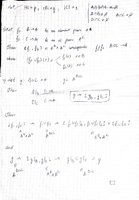In discrete maths class we started on cardinal numbers and one of the identities we proved was [MATH]p^q*p^r=p^{q+r}[/MATH]. It was done this way:
All parts of the proof to me seem reasonable (hope I translated it correctly). I just don't see why we had to show bijection 2 times. What for did we have to show this weird transformation from [f2,f2] to (f1 ∪ f2) to [f1 ∪ f2\B, f1 ∪ f2\A] to [f2,f2] and then from g and all the way back to g? Why isn't it enough to show the bijection between [f2,f2] and (f1 ∪ f2)? Those are elements from LHD and RHD of the equation we're proving.. Thanks!

All parts of the proof to me seem reasonable (hope I translated it correctly). I just don't see why we had to show bijection 2 times. What for did we have to show this weird transformation from [f2,f2] to (f1 ∪ f2) to [f1 ∪ f2\B, f1 ∪ f2\A] to [f2,f2] and then from g and all the way back to g? Why isn't it enough to show the bijection between [f2,f2] and (f1 ∪ f2)? Those are elements from LHD and RHD of the equation we're proving.. Thanks!

